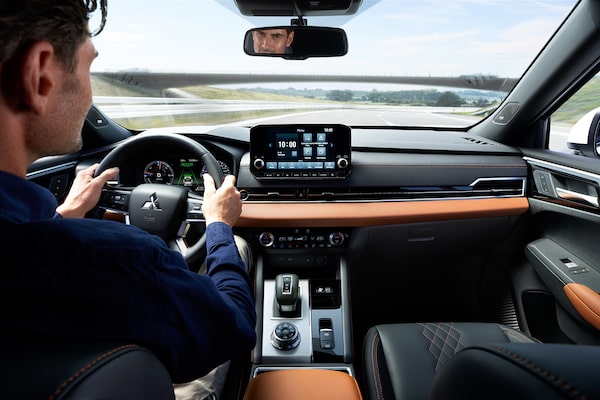Added range, power and options in Mitsubishi Outlander PHEV make switching to electric easier than ever
When we recently asked Globe and Mail readers to share their top two concerns with electric vehicles (EVs) over the next two years, the answers went hand-in-hand: driving range and a lack of charging stations.
Other surveys and statistics provide insights into that feedback.
On the range front, most EVs offer around 400 to 500 kilometres on a warm day in perfect conditions. Canadians have said they prefer 600 kilometres of range before they will consider an EV, according to a survey by the consulting firm Deloitte. And range drops in winter, thanks to frigid temperatures.
On the charging infrastructure front, Canada has committed to building 84,500 new charging stations by 2027, but currently there are fewer than 17,000 and the bulk of those are slow Level 2 chargers. A report from Natural Resources Canada indicates the country will need 440,000 public chargers by 2035.
That’s why, for many Canadians, purchasing a pure electric vehicle requires some kind of compromise.

SUPPLIED
“Given the geography of our country, people tend to have longer commuting distances than many other markets in the world, and because the infrastructure is still developing here, I don’t think every consumer has the confidence to go full battery electric at this point,” says Don Ulmer, senior manager of corporate and product strategy with Mitsubishi Motors Canada. “They’re not going to have the confidence that they can always find a charging station.”
He adds having the technology of a plug-in hybrid electric vehicle (PHEV), which combines an electric powertrain with a backup gas engine, eliminates range anxiety “because you know that there’s still going to be a gas station nearby and you can fill up the gas tank ... there is no compromise.”
Trying to meet lifestyle demands while also reducing carbon footprints is where a vehicle like the redesigned Mitsubishi Outlander PHEV comes in. It is also fast. The two electric motors at the front and rear axles heighten efficiency and provide instant torque, allowing the PHEV to accelerate to 100 kilometres per hour about two-seconds faster than the previous generation Outlander PHEV.
“There are no sacrifices going to a PHEV, for a traditional SUV buyer,” Ulmer says. “In fact, they’re getting a more sophisticated all-wheel-drive system. And it is more efficient, more ecological, especially for consumers who have a shorter commute. In all likelihood, they can drive back and forth to work on 100-per-cent electric and never actually use the gas. Purely, it’s just there as a backup.”
Ulmer says the Super All-Wheel Control (S-AWC), Mitsubishi’s all-wheel-drive system, on the PHEV is more sophisticated than ever because it distributes torque faster than a gas-powered car. It uses an electronic connection between the front and rear instead of a drive shaft.
He adds it is more efficient because the new version comes with the ability to travel 61 kilometres on a single charge. The average Canadian drives a little less than 20 kilometres a day for a commute to and from work. “You could drive all week on battery power and then if you need to do a road trip on the weekend, you have the gasoline engine, which will support you if you don’t have the time to stop and charge.”
Complimenting S-AWC and helping to improve range is a feature being introduced on the new Outlander PHEV called the Innovative Pedal. Drivers can use the accelerator pedal to accelerate and decelerate. “Once you’ve selected that feature, it uses maximum brake regeneration from the electric motors to slow the vehicle,” Ulmer says.
In certain situations, it will even apply the mechanical brakes without the driver pushing the brake pedal. In addition to improving range, “you’re getting better throttle modulation on slippery surfaces,” Ulmer says. “If somebody is using both Snow Mode and the Innovative Pedal at the same time, it provides for a much more assured driving feel in those situations.”

SUPPLIED
Ulmer says buyers can hop in the Outlander PHEV and drive it just like a normal car and the system will automatically adjust to driving conditions, your style of driving and other external factors.
It also offers four drive-surface modes, three drive-style modes and three EV modes that the driver can select, “where they can prioritize EV driving, or they can maintain a battery state of charge or they can charge the battery as they’re driving the vehicle.”
Ulmer says the intuitive design of the vehicle offers this smart control at the driver’s fingertips. The adjustments can be made with just a few easy-to-find buttons instead of having to dig deep into a menu on a touch screen.
Even though the EV range and the battery capacity has increased (20-kilowatt-hours up from 13.8), the physical size of the battery pack is smaller and so is the size of the rear motor. Mitsubishi was able to take that extra space and add a standard third row of seats, which comes in handy for the occasional carpool.
The Outlander PHEV is the only vehicle in its class to offer this this third row and the seats fold flat into the floor, meaning it has about the same cargo space as the gas-powered version of the Outlander.
“There is no compromise – it does everything that the customer expects with no sacrifice,” Ulmer says. “This fact – plus all of the improvements we’ve made since the previous generation – means it’s never been easier for anyone to make the switch to an electrified vehicle.”
Advertising feature produced by Globe Content Studio with Mitsubishi Motors. The Globe’s editorial department was not involved.